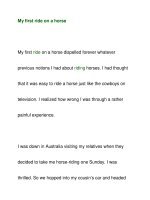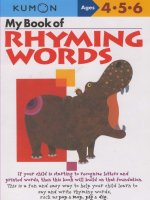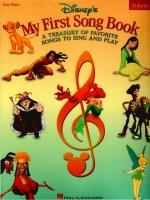my first britannica 3
Bạn đang xem bản rút gọn của tài liệu. Xem và tải ngay bản đầy đủ của tài liệu tại đây (3.19 MB, 97 trang )
CHICAGO LONDON NEW DELHI PARIS SEOUL SYDNEY TAIPEI TOKYO
MY FIRST BRITANNICA
The Arts
3
© 2008 by Encyclopædia Britannica, Inc.
International Standard Book Number:978-1-59339-476-9 (set)
No part of this work may be reproduced or utilized in any form or by any means, electronic or mechanical,
including photocopying, recording, or by any information storage and retrieval system, without permission
in writing from the publisher.
My First Britannica:
Volume 3: The Arts 2008
Britannica.com may be accessed on the Internet at .
Encyclopædia Britannica, Britannica, and the Thistle logo are registered trademarks of Encyclopædia Britannica, Inc.
The Arts
TABLE OF CONTENTS
INTRODUCTION. . . . . . . . . . . . . . . . . . . . . . . . . . . . . . . . 5
Visual Arts
Folk Arts and Crafts: Traditions of Creativity. . . . . . . . . . . 6
Painting: Art of the Mind’s Eye . . . . . . . . . . . . . . . . . . . . . 8
Sculpture: The 3-D Art . . . . . . . . . . . . . . . . . . . . . . . . . . 10
Architecture: The Art of Building . . . . . . . . . . . . . . . . . . . 12
ARTISTS
Hassan Fathy: Culture-Conscious Architect . . . . . . . . . . . 14
Hiroshige: Artist of the Floating World . . . . . . . . . . . . . . 16
Frida Kahlo: The Brilliant Colors of Mexico . . . . . . . . . . . 18
Michelangelo: Genius of European Art . . . . . . . . . . . . . . . 20
Diego Rivera: Murals of Mexico . . . . . . . . . . . . . . . . . . . . 22
Auguste Rodin: The Modern Michelangelo . . . . . . . . . . . . 24
Vincent van Gogh: Sunflowers and Starry Nights. . . . . . . 26
Xia Gui: Lonely Landscapes. . . . . . . . . . . . . . . . . . . . . . . 28
Music
Folk Music: Music of Everyday Life . . . . . . . . . . . . . . . . . 30
Popular Music: Music of an Era . . . . . . . . . . . . . . . . . . . 32
Jazz: The Music of Change . . . . . . . . . . . . . . . . . . . . . . . 34
Classical Music: A Very Formal Music. . . . . . . . . . . . . . . 36
MUSICIANS
Louis Armstrong: Satchmo—Jazz Superstar. . . . . . . . . . 38
Ludwig van Beethoven: Living for Music . . . . . . . . . . . . . 40
Nusrat Fateh Ali Khan: Center Stage of
Qawwali
. . . . . . . 42
Ladysmith Black Mambazo: The South African Sound . . . 44
Carlos Santana: Rock Guitarist . . . . . . . . . . . . . . . . . . . . 46
Ravi Shankar: Music at His Fingertips . . . . . . . . . . . . . . 48
Literature
Literature: Writing for the Ages . . . . . . . . . . . . . . . . . . . . 50
WRITERS
Basho:
Haiku
Master. . . . . . . . . . . . . . . . . . . . . . . . . . . . 52
Jorge Luis Borges: Creator of Fantastical Fictions . . . . . . 54
Gwendolyn Brooks: Prized Poet of Illinois . . . . . . . . . . . . 56
Lewis Carroll: The Man Who Created Wonderland . . . . . . 58
Emily Dickinson: A Life of Letters and Literature . . . . . . 60
Wole Soyinka: The Nobel Laureate. . . . . . . . . . . . . . . . . . 62
Rabindranath Tagore: Poet Laureate of India . . . . . . . . . 64
Jules Verne: Journey to Everywhere. . . . . . . . . . . . . . . . . 66
Kath Walker: Aboriginal Poet . . . . . . . . . . . . . . . . . . . . . 68
Performing Arts
Dance: Moving to Rhythms . . . . . . . . . . . . . . . . . . . . . . . 70
Theater: Life Re-created on a Stage. . . . . . . . . . . . . . . . . 72
Cinema: Dreams on the Big Screen . . . . . . . . . . . . . . . . . 74
Opera: A Grand Musical Play . . . . . . . . . . . . . . . . . . . . . . 76
PERFORMERS AND DIRECTORS
Alvin Ailey: Enriching American Dance . . . . . . . . . . . . . . 78
Sarah Bernhardt: “The Divine Sarah” . . . . . . . . . . . . . . . 80
Judi Dench: A Commanding Actress. . . . . . . . . . . . . . . . . 82
Jim Henson: Muppet Master . . . . . . . . . . . . . . . . . . . . . . 84
Akira Kurosawa: A Vision in Motion . . . . . . . . . . . . . . . . 86
Satyajit Ray: Indian Cinema for the World . . . . . . . . . . . . 88
Maria Tallchief: America’s Prima Ballerina. . . . . . . . . . . 90
Kiri Te Kanawa: New Zealand’s Opera Star . . . . . . . . . . . 92
GLOSSARY. . . . . . . . . . . . . . . . . . . . . . . . . . . . . . . . . . . 94
INDEX . . . . . . . . . . . . . . . . . . . . . . . . . . . . . . . . . . . . . . 95
Cover photos (top): “The Sunflower,” by Vincent Van Gogh, © Christie’s Images/Corbis; (center): traditional Peking opera performance, © Marc Garanger/Corbis;
(bottom): Kermit the Frog, © & TM 2003 The Jim Henson Company. THE MUPPET SHOW mark & logo, MUPPET, MUPPETS, KERMIT, characters and elements
are trademarks of The Jim Henson Company. All Rights Reserved.
Kermit the Frog
© & TM 2003 The Jim Henson Company.
THE MUPPET SHOW mark & logo, MUPPET,
MUPPETS, KERMIT, characters and elements
are trademarks of The Jim Henson Company.
All Rights Reserved.
The Arts
MY FIRST BRITANNICA
Have a great trip!
In Volume 3,
The Arts
,
you’ll discover answers to
these questions and many
more. Through pictures,
articles, and fun facts,
you’ll learn about the many
kinds of art and meet some
of the greatest artists of
yesterday and today.
INTRODUCTION
Where did jazz come from? When did films begin to talk?
What do you call a musical play?
Who was Basho and what’s a
haiku
?
To help you on your journey, we’ve provided the following guideposts in
The Arts
:
■ Subject Tabs—The colored box in the upper corner of each right-hand
page will quickly tell you the article subject.
■ Search Lights—Try these mini-quizzes before and after you read the
article and see how much—and how quickly—you can learn. You can even
make this a game with a reading partner. (Answers are upside down at the
bottom of one of the pages.)
■ Did You Know?—Check out these fun facts about the article subject.
With these surprising “factoids,” you can entertain your friends, impress
your teachers, and amaze your parents.
■ Picture Captions—Read the captions that go with the photos. They
provide useful information about the article subject.
■ Vocabulary—New or difficult words are in bold type. You’ll find
them explained in the Glossary at the back of this volume. And there’s a
complete listing of all Glossary terms in the set in the Reference Guide
and Index, Volume 13.
■ Learn More!—Follow these pointers to related articles throughout the set.
And don’t forget: If you’re not sure where to start, where you saw something
before, or where to go next, the Index at the back of this volume and the
Reference Guide and Index (Volume 13) will point the way.
6
Most of us have been to museums that display art by famous painters
and sculptors. But another sort of artwork is common to almost every
culture—the arts and crafts of nonfamous but skilled people who carry on
the traditions of their ancestors.
Folk art has its name because it’s made by the “folk,” or common
people, rather than by professional artists. Farmers, shepherds, fisherfolk,
and tradespeople who live away from
cities are often the creators of folk art.
Some are very skilled. European
sailors used to carve beautiful
scrimshaw, or delicately engraved
pieces of whalebone or ivory. Today
people in India, Ghana, Indonesia, and
other places make beautiful fabrics in
patterns unique to their regions.
In less-industrialized countries in
Asia, Africa, and Latin America, so
many folk arts and crafts are exported that craftspeople can often make a
living at their art. Many of these countries support their craftspeople,
usually by helping them to sell their work.
Folk artists typically produce useful things such as furniture, toys,
jewelry, clothing, musical instruments, weapons, religious symbols, and
household tools. They craft these objects from easy-to-find or
recycled materials such as wire, wood, and natural fibers.
Some people even make food into art.
Every region of the world has produced folk art in
unique styles. Folk art frequently reflects the traditional
wisdom, religious beliefs, and superstitions of a society. The
art often focuses on important yet common events—births,
marriages, funerals, and holidays.
L
EARN MORE! READ THESE ARTICLES…
FOLK MUSIC (VOLUME 3) • MYTHS AND LEGENDS,FOLKTALES
AND FABLES (VOLUME 5) • SCULPTURE (VOLUME 3)
T
r
a
d
i
t
i
o
n
s
o
f
C
r
e
a
t
i
v
i
t
y
What
material is
used to make
scrimshaw?
S
E
A
R
C
H
L
I
G
H
T
Hand-painted eggs from Ukraine, in eastern Europe.
© Craig Aurness/Corbis
7
Answer: Scrimshaw uses whalebone or ivory as a surface
for carvings.
★
FOLK ARTS AND CRAFTS
DID YOU KNOW?
As part of the Mexican festival called
the Day of the Dead—el Día de los
Muertos—sugar is formed into
skeletons, coffins, and angels. These
tasty pieces of folk art often serve as
toys before they are eaten!
Native American Hopi artists carve kachina dolls,
representing spirits of ancestors. Children learn about
the kachina spirits while they play with the dolls.
© Tom Bean/Corbis
8
Apainting is a two-dimensional, or flat, work of visual art. It is created
by applying some form of color or paint to a surface.
Some artists paint what they see around them. Others paint pictures
that they see in their imagination. The idea on which a painting is based is
called its “theme.”
Some paintings have a religious theme. For example, one of the most
famous paintings in the world, Leonardo da Vinci’s “Last Supper,” shows
Jesus Christ sharing his final meal with his disciples.
Other paintings show famous legends and events in history. Or they
show landscapes, animals, or even scenes from daily life. Many Chinese
scroll paintings take landscapes and nature as their themes.
Artists also paint portraits, or pictures of people. Sometimes they paint
pictures of themselves. Such paintings are called “self-portraits.”
Some painters express ideas
and feelings through lines,
shapes, colors, and textures that
don’t look like anything you
could recognize. Such paintings
are called “abstract paintings.”
Painters use many materials
in their works. These include oil
paints, acrylics, watercolors,
pastels, inks, dyes, and enamel
paints. Painters use different tools to apply these colors, like brushes of
various sizes and flexible tools called “palette knives.”
You probably know that many paintings are made on canvas or paper.
But paintings can also be applied to different surfaces. Murals are paintings
on walls, both indoors and outdoors. Frescoes are wall paintings made on
wet plaster. And some Native Americans paint without paint in an art
known as “sand painting.”
In Islamic countries and in East Asia, especially Japan, Korea, and
China, calligraphy—the art of beautiful writing—is a skill equal to
painting. Calligraphy is usually done in ink, using a brush.
L
EARN MORE! READ THESE ARTICLES…
VINCENT VAN GOGH (VOLUME 3) • PABLO PICASSO (VOLUME 4)
XIA GUI (VOLUME 3)
A
r
t
o
f
t
h
e
M
i
n
d
’
s
E
y
e
(Left) Navajo man making a sand painting. (Right) Classroom artist-in-training.
© Ariel Skelley/Corbis
© Danny Lehman/Corbis
PAINTING
9
Answer: Calligraphy is beautiful writing done in ink.
★
A young artist works on a painting in a public exhibit
at the Palace of Fine Arts in Santiago, Chile.
© Pablo Corral V/Corbis
Find and
correct the
error in the
following sentence:
Calligraphy is a
self-portrait done
in ink.
S
E
A
R
C
H
L
I
G
H
T
DID YOU KNOW?
Early humans made paintings on the
walls of caves some 15,000 years
ago. Some of those paintings can still
be seen in France, Spain, and other
parts of Europe.
DID YOU KNOW?
Mount Rushmore National
Memorial, in South Dakota, is
a huge hillside carving by
Gutzon Borglum of the faces of
four U.S. presidents. If those
presidents’ whole bodies were
carved too, they’d stand over
450 feet tall. Abraham
Lincoln’s nose by itself is 21
feet long.
11
SCULPTURE
Sculpture is a three-dimensional visual art. Paintings, drawings,
and photographs are all two-dimensional, or flat. Sculptures are
most often shaped by carving, molding, or welding materials.
Some are formed by making a cast—that
is, by pouring a liquid in a mold and
letting it harden.
Sculpture, like other arts, is often made to
express thoughts or feelings. People who look at it
might respond with thoughts or feelings of their
own. Because it can have shape and texture,
sculpture may appeal to our sense of touch.
Some sculptures are realistic. Until the middle
of the 20th century, most sculpture was meant to
look like some person or thing. The giant stone faces
on Easter Island, like much traditional sculpture,
may have been meant to honor gods or heroes. Other
famous realistic sculptures include Michelangelo’s
“David” and Auguste Rodin’s “The Thinker.”
Some modern sculptures may be abstract. This means they only hint at
an object or an idea. They may not look like people or things you would
recognize. These sculptures try to communicate a pure feeling or idea.
Sculptures come in all sizes, shapes, textures, and materials. Sculptors
may use soft materials such as clay, wax, or wood or harder materials such
as stone or metal. Sometimes the materials aren’t even meant to last. One
artist makes sculptures out of milk!
The modern sculptor Alexander Calder made sculptures that hang in
the air. He called these “mobiles,” which means “moving things.” Another
modern sculptor, named Christo, makes sculptures by wrapping such
things as bridges, buildings, and even small islands in fabric and plastic.
L
EARN MORE! READ THESE ARTICLES…
FOLK ARTS AND CRAFTS (VOLUME 3) • MICHELANGELO (VOLUME 3)
AUGUSTE RODIN (VOLUME 3)
T
h
e
3
-
D
A
r
t
Classical bronze sculpture by
Donatello of Italian military figure
Gattamelata.
© Elio Ciol/Corbis
Modern sculpture, such as Claes Oldenburg’s “Clothespin” (in
Philadelphia, Pennsylvania, U.S.), often places common objects in
unusual situations to make us see and think about them differently.
© Robert Holmes/Corbis
Fill in
the blanks:
Sculpture is
different from
painting because
while a painting is
_______, a sculpture
is _______-_______.
S
E
A
R
C
H
L
I
G
H
T
Answer: Sculpture is different from painting because while a
painting is flat
, a sculpture is three-dimensional
.
★
12
The Eiffel Tower
in Paris, one of
the world’s most
admired
architectural
marvels, was
mocked and
insulted by many
artists as it was
being built.
French novelist
Léon Bloy called
it “this truly
tragic
streetlamp.”
DID YOU
KNOW?
Fill in
the blank:
Architecture is
the art of
____________.
S
E
A
R
C
H
L
I
G
H
T
The architect of the Baha’i House of Worship in India
designed it to look like India’s national flower. It has
thus come to be called the Lotus Temple. Fine
architecture is in tune with its cultural environment.
© Dallas and John Heaton/Corbis
13
Thousands of years ago, early human beings lived in caves or other
natural formations. As time passed, people learned new skills, developed
new tools, and were able to build simple shelters.
As societies developed, they needed more kinds of buildings. Soon
forts, barns, schools, bridges, tombs, and temples were being built, using a
variety of materials. Gradually, creating buildings became an activity for
experts—an art and occupation that came to be
known as “architecture.”
Today architecture is a refined art requiring
a lot of training, years of practice, and plenty of
talent. An architect’s work is to imagine and
plan a building and then to supervise its
construction.
The architect must keep many things in
mind. For example, what is the building going
to be used for and by whom? Where will it be
located? What would be the best materials to
use? How much money will construction cost?
Architects also try to create buildings that
people like to look at as well as to live, work,
and play in. And changing styles affect
architecture just as happens in other arts. The next time you see or walk
around a city, notice the various styles of buildings. You’ll find many
differences between those designed recently and those of even 50 or 100
years ago. Different countries and cultures also produce different styles of
architecture.
People today are still amazed at the buildings created by long-ago
architects. The majestic pyramids in Egypt, the Great Wall of China, the
temple at Angkor Wat in Cambodia, and the Taj Mahal in India are some of
the architectural wonders you can study and visit.
L
EARN MORE! READ THESE ARTICLES…
HASSAN FATHY (VOLUME 3) • I.M. PEI (VOLUME 4) • TAJ MAHAL (VOLUME 7)
Answer: Architecture is the art of building.
★
ARCHITECTURE
T
h
e
A
r
t
o
f
B
u
i
l
d
i
n
g
The Cathedral of Notre-Dame de Paris
(begun in 1163), an example of Gothic
architecture.
© Bill Ross/Corbis
14
The Sadat Resthouse (built in Garf Huseyn, Egypt,
in 1981) shows some of Hassan Fathy’s trademark
features. Here you can see the thick walls and air
scoops that help cool the building naturally.
DID YOU KNOW?
Hassan Fathy is quoted as
having said, “Architecture
is music frozen in place
and music is architecture
frozen in time.” What do
you suppose he meant
by this?
15
Hassan Fathy is famous as a humanitarian architect. He built
homes and buildings that put people’s needs first. Fathy was
born in 1900 in Alexandria, Egypt. He studied there and began
his career in Egypt.
Fathy’s goal was to build affordable housing for local
Egyptian people. He felt that many European building methods and
designs that had come into his country weren’t right for it. He
thought houses should be built from local materials, according to
local designs, and with traditional methods. By building this
way, he lowered the cost of his houses and respected the culture
of the area as well. In addition, traditional methods and
materials tended to suit the local climate best.
Because Egypt is a very hot country, it is important to make houses as
cool as possible. Fathy’s buildings often had thick walls (to keep out heat)
surrounding interior courtyards. Air scoops on the roofs caught winds from
the desert and funneled them down through the
buildings. By these natural methods, Fathy
managed to keep the houses cool inside.
One of Fathy’s most famous creations was
the New Gourna Village near Luxor, Egypt. The
original village was near the archaeological
digs of ancient Luxor and had to be relocated.
Fathy trained the local people in the ancient
tradition of mud-brick construction. The people
then built themselves new homes that were
almost entirely of mud bricks and that kept all
the good features of their former homes.
Fathy died in 1989, but his work has inspired many young architects in
the Middle East. He promoted ideas that adapted traditional styles and
methods to the needs of the present day.
L
EARN MORE! READ THESE ARTICLES…
ARCHITECTURE (VOLUME 3) • EGYPT (VOLUME 8) • I.M. PEI (VOLUME 4)
Answer: c) mud.
★
HASSAN FATHY
C
u
l
t
u
r
e
-
C
o
n
s
c
i
o
u
s
A
r
c
h
i
t
e
c
t
The New
Gourna Village
was built of
a) sticks.
b) straw.
c) mud.
S
E
A
R
C
H
L
I
G
H
T
Hassan Fathy.
Courtesy of the Aga Khan Trust for Culture
Courtesy of the Aga Khan Trust for Culture
This painting, called “Festival Day,” is from Hiroshige’s
Tokaido Road series. In it, travelers climb to a restaurant
perched on a scenic overlook.
© Asian Art & Archaeology, Inc./Corbis
17
Ando Hiroshige was a Japanese painter and printmaker who
was especially famous for his pictures of landscapes. Hiroshige
was one of the ukiyo-e painters. “Ukiyo-e” is a Japanese term
that means “pictures of the floating world.”
Hiroshige was born in 1797. When he was 14, Hiroshige
joined the school of the ukiyo-e master Utagawa Toyohiro. He
graduated as an artist from the school at only 15. His first work
was published six years later, in 1818.
Hiroshige probably created more than 5,000 prints during his
lifetime. His life as an artist was divided into three stages. The
first stage was when he was a student. He followed the style of
his teachers in making prints of people. He drew girls, actors,
and samurai, or warriors.
During the second stage, Hiroshige made landscape designs and prints
of birds and flowers. His best works during this time were 55 landscape
prints called the “Fifty-three Stations of the Tokaido.” Tokaido was a road
that connected the Japanese cities of Osaka, Kyoto, and Edo (now called
Tokyo). Along the road were 53 towns. Inns in each town provided
lodging, food, and gifts for travelers. Hiroshige made one print for each
town, as well as one each for the beginning of the highway and the arrival
in Kyoto. Many people bought copies of the prints. Hiroshige was soon
one of the most popular ukiyo-e artists of all time.
In the last stage of his work, Hiroshige illustrated more landscapes,
some empty and some with people in them. But he did far too much work,
and his later work wasn’t his best.
It has been estimated that Hiroshige created more than 5,000 prints. He
knew how to create very simply and beautifully what he saw.
Answer: Hiroshige was famous for his pictures of stops along the
Tokaido Road.
★
HIROSHIGE
F
l
o
a
t
i
n
g
W
o
r
l
d
A
r
t
i
s
t
o
f
t
h
e
What
important
road was the
subject of many
of Hiroshige’s
paintings?
S
E
A
R
C
H
L
I
G
H
T
LEARN MORE! READ THESE ARTICLES…
BASHO (VOLUME 3) • JAPAN:MODERN NATION OF
ANCIENT TRADITIONS (VOLUME 7) • XIA GUI (VOLUME 3)
DID YOU KNOW?
The Tokaido Road had been in use for
over 700 years when Hiroshige began
to make pictures of it.
18
Frida
Kahlo’s
most famous
paintings were
a) murals.
b) self-portraits.
c) buses.
S
E
A
R
C
H
L
I
G
H
T
FRIDA KAHLO
19
Mexican painter Frida Kahlo’s life was filled with struggles. But her
dazzlingly colorful self-portraits reflect Kahlo’s power and confidence in
the face of her hardships.
When Kahlo was a child, she had polio, and the disease kept her right
leg from growing properly. Then, when she was 18, Kahlo was in a terrible
bus accident. For the rest of her life, she had many operations to try to
correct both of these problems.
Kahlo began to paint while she was recovering from the bus accident.
Her paintings were often dramatic self-portraits that showed Kahlo’s
powerful feelings about herself and the world she lived in. Their brilliant
colors reflect Kahlo’s strong attitude toward life.
Before the bus accident, Kahlo had met the famous Mexican painter
Diego Rivera while he was painting a mural at her school. Later she
showed Rivera some of her paintings, and he encouraged her to keep
working at her art.
Kahlo and Rivera were married in 1929. They traveled to the United
States, where Diego had received commissions for murals. Kahlo kept
painting and met many important people of the time. The artist Pablo
Picasso admired her work. And many of her well-known friends helped her
show her paintings in Europe and America.
Kahlo’s work was called “surrealistic” by some. Surrealism is a style
of art that has a strange dreamlike quality. Kahlo, however, said that her
paintings were the reality that she felt and that they spanned reality and
dreams.
In the spring of 1953, Kahlo had the only exhibition of her work in
Mexico. She died one year later. Today her house in Coyoacán is the Frida
Kahlo Museum.
L
EARN MORE! READ THESE ARTICLES…
MEXICO (VOLUME 9) • PAINTING (VOLUME 3)
DIEGO RIVERA (VOLUME 3)
Answer: b) self-portraits.
★
T
h
e
B
r
i
l
l
i
a
n
t
C
o
l
o
r
s
o
f
M
e
x
i
c
o
Frida Kahlo was the first Hispanic woman to be featured
on a U.S. postage stamp. The stamp, seen here being
unveiled, featured one of her famous self-portraits.
© AFP/Corbis
DID YOU KNOW?
Kahlo was very proudly Mexican. She
often wore very decorative Mexican
jewelry and native clothing. Her
hairstyle, piled high on her head, was
also in the style of the people of the
Mexican state of Oaxaca.
20
Michelangelo’s “David” is being
cleaned and repaired. It is often
considered the finest example
of the Renaissance ideal. During
the Renaissance (“Rebirth”), art
and literature blossomed richly.
David was
the name of
Michelangelo’s
a) teacher.
b) student.
c) statue.
S
E
A
R
C
H
L
I
G
H
T
© AFP/Corbis
MICHELANGELO
21
Answer: c) statue.
★
Once there was a small boy in Florence who loved to watch painters and
sculptors at work. He wanted to be an artist, but his father did not like the
idea. Little did the man know that his son Michelangelo would become one
of the world’s most famous artists.
Michelangelo began training as an artist at age 13.
He was so interested in his art that he often forgot to eat
and slept on the floor beside his unfinished artwork. He
refused help, even on big projects, so some works took
years to complete. Many were never finished.
Michelangelo worked in Rome and Florence. In
Rome he was commissioned to carve a Pietà. This is a
marble statue showing the Virgin
Mary supporting the dead Christ on
her knees. The finished work, known
as the “Madonna della Pietà,” made
him famous. And in Florence,
Michelangelo spent two years
working on a huge block of marble.
From it he carved “David,” one of the
world’s finest and best-known
sculptures.
Between 1508 and 1512
Michelangelo created his most
famous work, the paintings on the
ceiling of the Sistine Chapel in
Rome’s Vatican. He painted much of the ceiling while lying on his back in
a tight cramped position. The fresco paintings of figures and events from
the Bible are huge and splendid. The wall behind the altar
depicts the Last Judgment of humanity by God.
Michelangelo was so admired that he became the
first European artist whose life story was written
during his own lifetime.
L
EARN MORE! READ THESE ARTICLES…
BIBLE (VOLUME 5) • SCULPTURE (VOLUME 3)
VATICAN CITY (VOLUME 6)
G
e
n
i
u
s
o
f
E
u
r
o
p
e
a
n
A
r
t
(Top) Portrait of Michelangelo. (Bottom) Michelangelo’s
frescoes on the Sistine Chapel ceiling and west wall
(behind the altar).
© Pizzoli Alberto—Corbis/Sygma
DID YOU KNOW?
Despite all the time that went into
his artwork, Michelangelo found time
to design buildings, write poems,
and even create defensive structures
for Florence.
© Stefano Bianchetti/Corbis
When he was only 10 years old, Diego Rivera
received a government scholarship to study art at
the Academy of San Carlos in Mexico City. This
would be the beginning of a brilliant art career.
Later, Rivera studied in Spain, and in 1909
he moved to Paris. There he became friends
with important painters such as Pablo Picasso
and Georges Braque. While in France, Rivera
began using simple forms and bold colors in
his painting.
Rivera returned to Mexico in 1921 after meeting fellow Mexican
painter David Alfaro Siqueiros. The two shared a goal. They decided to
create a new, uniquely Mexican kind of art based on revolutionary
themes. They wanted this art to decorate public buildings, so they decided
to paint murals. Murals are paintings done on walls, either inside or outside
of buildings. Rivera painted his first important mural, “Creation,” for the
National Preparatory School in Mexico City.
M
u
r
a
l
s
o
f
M
e
x
i
c
o
DID YOU KNOW?
The owners of Rockefeller Center in
New York City destroyed Rivera’s
mural there because it featured
communist leader Vladimir I. Lenin.
That mural would now be worth
millions. Rivera later painted a copy
in Mexico City.
22
23
Rivera’s many murals in his home country celebrated
Mexican history and life. His paintings featured native Indians,
Spanish conquistadores, Mexican peasants, factory workers, and famous
philosophers, politicians, and other public figures. He liked to show how
farming, industry, and culture were all connected in people’s lives. His
human figures had a flattened appearance and were outlined to emphasize
their shape. His works were brightly colored and crowded with figures,
which made his huge murals seem even larger.
Rivera was in the United States from 1930 to 1934. There he painted
murals for the California School of Fine Arts in San Francisco, the Detroit
Institute of Arts, and Rockefeller Center in New York City.
Rivera’s wife, Frida Kahlo, was also an important painter.
L
EARN MORE! READ THESE ARTICLES…
FRIDA KAHLO (VOLUME 3) • MEXICO (VOLUME 9) • PABLO PICASSO (VOLUME 4)
Answer: a) bold colors
★
DIEGO RIVERA
Which of
the following
qualities
applies to
Rivera’s work?
a) bold colors
b) quiet pictures
c) pale colors
S
E
A
R
C
H
L
I
G
H
T
Like many of Rivera’s murals, this one focuses on the life
of the common people. The mural, called “Pan American
Unity,” is painted on a wall at City College of San Francisco.
All rights reserved. Unauthorized public performance, broadcasting,
transmission, or copying, mechanical or electronic, is a violation of
applicable laws. © City College San Francisco.
24
The French sculptor Auguste Rodin was
interested in art even as a boy. At age 10, he
started drawing. By the time he was 15,
Rodin had discovered the art of sculpture.
Rodin started out working for building
decorators. He made decorative designs for the
outsides of buildings. Later, Rodin became a
sculptor’s assistant. He worked with the sculptor A E. Carrier-Belleuse.
In 1864, at age 24, Rodin publically showed his first major sculpture,
“The Man with the Broken Nose.” The official art critics of the time did
not like it. They believed art should be about beauty. To them, Rodin’s
sculpture was about something “ugly” and ordinary.
At age 35, Rodin went to Italy to study the work of the famous painter
Michelangelo. He learned a great deal about the human form. His work
began to look even more realistic. It seemed to be full of movement and
drama.
When he was 37 years old, Rodin sculpted “The Age of Bronze.” It
was so unusual and realistic that people said he must have molded it on a
real person! After years of struggle, Rodin finally had become known as a
great sculptor.
Rodin’s sculptures were usually cast in bronze or carved from marble.
The bronze pieces could be duplicated many times, using an original
piece that was molded in clay.
The piece that Rodin is probably best known for is his statue
“The Thinker,” shown in the photo here. Like almost all of his
sculptures, it shows a person in a natural, everyday pose. But
Rodin’s work seems to show a reality and truth that people may
not have noticed before. Many people still find that his work
symbolizes the things that we all experience and feel.
T
h
e
M
o
d
e
r
n
M
i
c
h
e
l
a
n
g
e
l
o
© Owen Franken/Corbis
DID YOU KNOW?
One of Rodin’s most important
sculptures, “The Gates of Hell,” was
actually used as the doors of an art
museum. Within it are many smaller
sculptures. Many of them were early
versions of what became some of
Rodin’s finest works.
Fill in
the blanks:
The officials who
studied and judged
art felt that Rodin’s
first major work was
_______ and _______.
S
E
A
R
C
H
L
I
G
H
T
LEARN MORE! READ THESE ARTICLES…
FRANCE (VOLUME 6) • MICHELANGELO (VOLUME 3)
SCULPTURE (VOLUME 3)









